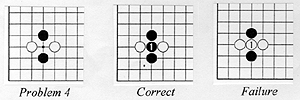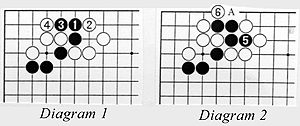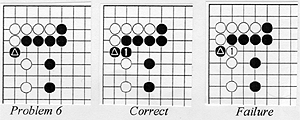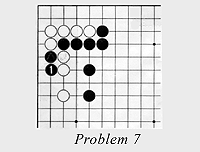Dosaku and Shusaku: The saints of go
The Kisei title is currently being contested by two of the most successful tournament players of the modern age: Cho Chikun and Koichi Kobayashi. The first two games have already been played, and Cho won both of them.Kisei means go saint, and to be called Kisei is the highest accolade a go player can receive. Before the Kisei title was founded 24 years ago by The Yomiuri Shimbun, only two players were honored with this title: Dosaku and Shusaku. Both towered above their contemporaries, and both made important contributions to the development of go theory.
Honinbo Dosaku (1645-1702)
Dosaku learned go at the age of 7, and at 22 became the 4th head of the prestigious Honinbo house. At that time, there were no players who could hold their own against him, even when they played the first move in a game. In fact, it is estimated that he was nearly two stones stronger than his nearest rivals. He was the master tactician in an era filled with strong tactical fighters, and his games are filled with spectacular sacrifices. Even today, his games are studied as examples of brilliant tactical technique. In opening strategy as well, none of his contemporaries could approach him, and he is credited with laying the foundations of modern opening theory. In 1678, at the age of 23, he was appointed to fill the highest post that a go player could rise to, Meijin and head of the godokoro, the go bureau that controlled all official matters related to go.During his life, Dosaku had four great prodigies as his disciples. Doteki was the best of them and, at 13, was almost as strong as Dosaku himself. Unfortunately, Doteki died when he was only 21, and the others died at early ages as well.
Shusaku (1829-62)
Shusaku was born on May 29, 1829. He learned go at the age of 4, and quickly became famous as a go prodigy. By the age of 10, he had achieved the rank of 1-dan. At 14, Shusaku was already a 4-dan and he was the hope of the Honinbo house. He was fast developing a reputation as an invincible player, but what convinced everyone that he was a great go genius were his wins against Gennan Inseki.Gennan was the preeminent player of the day, and although his ambition to attain the highest rank of Meijin was blocked by the Honinbo house he was considered to be of Meijin strength.
The ear-reddening game
In 1846, Shusaku made a trip back to his home in Shikoku. During his trip, he stopped off in Osaka, where it was arranged for him to play some games with Gennan. In the first game, Shusaku took a handicap of two stones, but the game was suspended after 102 moves because Gennan realized that Shusaku was too strong for that handicap. In the next game, Shusaku played at the handicap of first move. On move 25, Shusaku made a mistake, and Gennan seemed to have an advantageous position. However, Shusaku's 127th move was profound, a move of genius. After it was played, a number of Gennan's disciples analyzing the game in another room were still convinced that Gennan was ahead, but a doctor in the room watching the game said he thought that Shusaku would win. When asked why he thought so, he replied: "I don't know much about go, but when Shusaku played that move, Gennan's ears flushed red. This showed that the move upset him and he was taken by surprise.Indeed, it was the turning point of the game, and from then on Shusaku gradually took the lead and finally won by 3 points.
Three more games were played, and Shusaku won two of them with Gennan suspending one after 59 moves, apparently because he was hopelessly behind.
This encounter with Gennan firmly established Shusaku's reputation. Shusaku lived in an age filled with great go geniuses, but he forced them all to play with a handicap against him.
Shusaku's games are considered to be the best model for aspiring go players to study. He had complete mastery of the strategic principles and the practical techniques of go. His fighting in the middle game was unrivaled, and all of his moves were backed up by profound analysis. It is probably no exaggeration to say that Shusaku is the greatest go player who ever lived, well deserving the accolade "Go Saint."
Answers to last week's problems
Here are the answers to the problems I gave in last week's column.Problem 4. You were asked to link up the two black stones. The correct answer is to play Black 1. The three black stones are now linked up. On the other hand, White's two stones are separated. By looking at this position, it should be clear that Black's position is strong and powerful, while White's two stones are weak. We refer to Black's position as thick and White's as thin.
If Black neglects to play as in the correct answer, White will get the chance to play at 1 himself, and it is now White who is strong, while Black is weak.

Problem 5. Connecting at Black 1 in the correct answer is a big move. All of black's stones are linked up, while White is split into two separated positions.
If Black neglects to link up his stone at the top with his three below, White will play at 1 in the failure diagram, and the black stone at the top is isolated. Moreover, this stone cannot escape and will be captured, so White will get all the territory at the top. For example--

If Black descends to 1 in Diagram 1 White will play 2. After Black 2 and White 3 are exchanged--
The black stones are trapped, Black has no viable move. If he plays at 5 in Diagram 2, White plays 6 and the black stones have only one liberty. White can capture the four black stones by playing at A.
Problem 6. The correct answer is for Black to connect at 1. All the black stones are now linked up.
If Black fails to play 1 in the correct answer, White will cut off the marked stone with 1 in the failure diagram. The marked stone is as good as captured, and the territory on the left side now belongs to White.


Problem 7. Continuing from the failure diagram in Problem 6, suppose Black tries to escape by playing at 1 here. How can White capture the two black stones?

